Last Chance to Catch NYC's Holiday Notalgia Train
We met the voices of the NYC subway on our nostalgia ride this weekend!



Photo by Jacob A. Riis. Image via Museum of the City of New York, Gift of Roger William Riis
Today, most people probably know of journalist and social reformer Jacob A. Riis through the photographic collection he left behind. But perhaps the most surprising thing you’ll learn about the Danish-born, New York transplant in the new Museum of City of New York exhibit Jacob Riis: Revealing New York’s Other Half is that photography was merely a supporting part of Riis’ larger journalistic legacy. In fact, while Riis kept careful documentation of his written work – manuscripts, correspondence, clippings, annotated notebooks – he left the photographs in the attic of his house in Queens.
By deconstructing the prevailing myth and narrative that surround Riis, curator Bonnie Yochelson reveals not only the other half of New York City during the late 19th century and early 20th century, but also the other sides of Riis himself. While Riis’ photographic collection belongs to the Museum of the City of New York, this is the first ever exhibition of Riis’ archive, which belongs primarily to the Library of Congress and the New York Public Library.

At the root of this reveal is how modern of a journalist Riis was, an approach that made him an outsider in his era. He used the “state of the art media of his day,” Yochelson tells us, all which have counterparts today. The traveling lantern slide lectures Riis gave around the country can be likened to a TED Talk, his type of photography akin to Instagram – making Riis all the more relevant in the modern era.
“He published in national magazines, then collected his articles to publish a book, and then he’d go on tour. We know this [process]” says Yochelson. Sometimes the reverse would occur: Riis’ most famous book, How the Other Half Lives began as a lecture tour. A recreation of Riis’ traveling lecture, entitled “How the Other Half Lives and Dies in New York,” shows in the back room of the museum exhibit (and embedded below). The voiceover is derived directly from a script found in one of Riis’ notebooks and narrated here by Terry Borton of the American Magic- Lantern Theater. The music that plays in the slideshow, the hymn “Because He Loved Me So” is mentioned in the notebook and the images were matched up by Yochelson from Riis’ notes.
That photographs could be works of art, or objects that stood alone, was not something Riis was contemplating, nor did he consider himself a photographer. “He had no idea of authorship. He was trying to use pictures to enhance his message,” explains Yochelson. Many photographs weren’t even taken by Riis himself, who was known to outsource the documentation work at times.
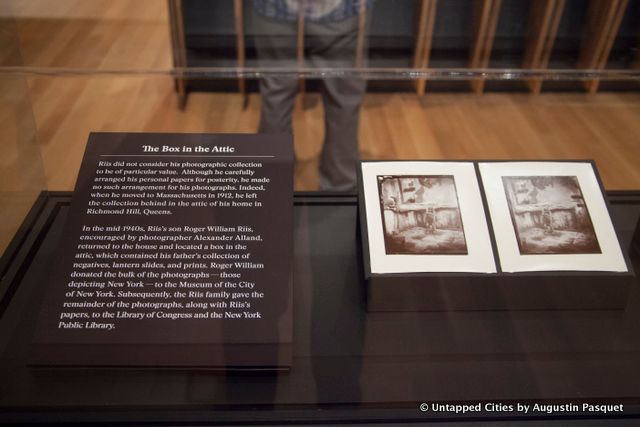
Riis’ photographs were only discovered in the 1940s, decades after his death in 1914, by Alexander Alland, a fine art photographer. As Yochelson says, Alland “brought Riis to public attention as a photographer with a show at the Museum of the City of New York in 1948 by taking Riis’ negatives and making beautiful prints. He kind of twisted our idea of Riis as a photographer to a mid-20th century idea of what a photographer is, which is basically an artist.” Indeed, one showcase in the exhibit today shows an original Riis photograph side by side with an Alland print of the same, which had been cropped to create a different depth of field and focus. The show, says Yochelson “is in part of an effort to reframe those issues – to say no, Riis was a journalist, first and foremost.”
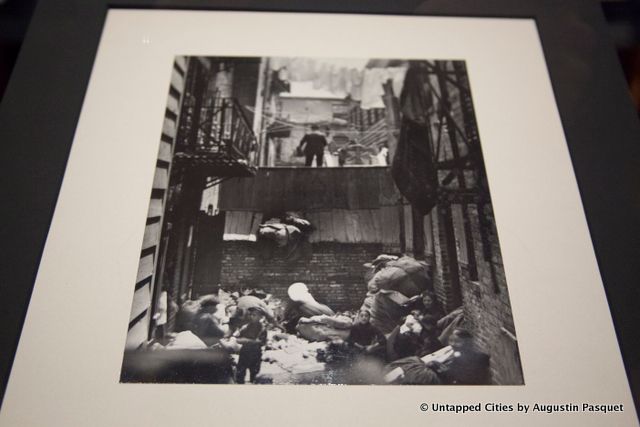
An Alland edit of a Jacob A. Riis photograph
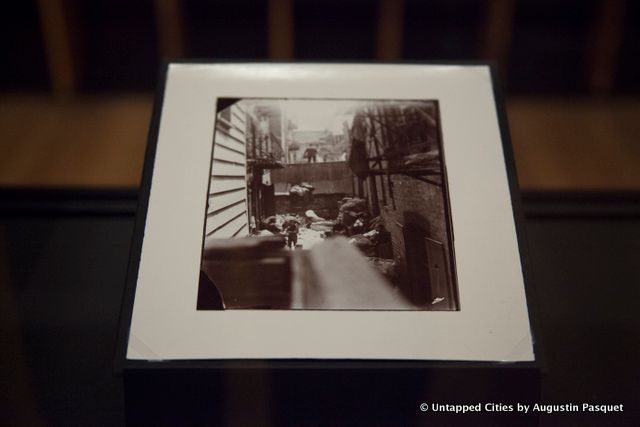
The original photograph by Jacob A. Riis
Riis’ contextual use of photographs “makes much more sense to a digital age sensibility than a 20th century sensibility,” contends Yochelson. Similiary, while How the Other Half Lives is the book Riis is most known for, it does not contain his most modern of tropes. Conversely, his 1901 autobiography, The Making of an American, also a bestseller was “very modern,” says Yochelson, a tell-all that recounted Riis’ immigrant journey, his initial failures, battles with homelessness, job security and his quest for romance.
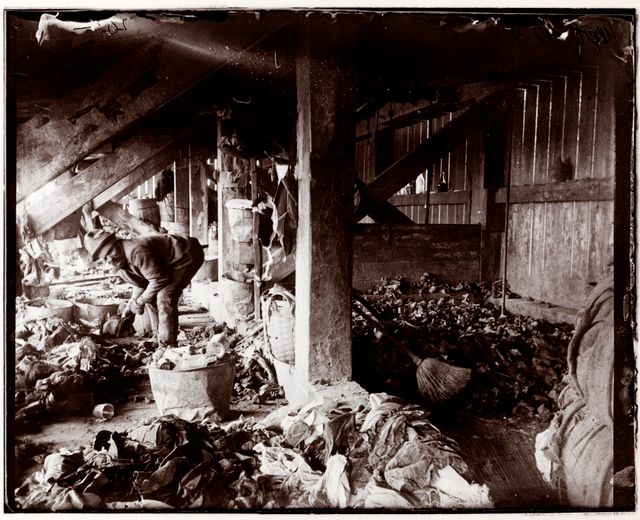
Under the Dump at West 47th Street. Photo by Jacob A. Riis. Image via Museum of the City of New York, Gift of Roger William Riis

Bandit’s Roost. Photo by Jacob A. Riis. Image via Museum of the City of New York, Gift of Roger William Riis
As Yochelson recounts, “he builds the arc of his autobiography around a love story – very contemporary – and then he has a second ace up his sleeve” which is Teddy Roosevelt, who had asked Riis for help when he became New York City’s police commissioner. Through their “bromance,” as Yochelson describes, upper class Roosevelt gained access into the slums of New York City and as the exhibition describes, “The two men supported each other publicly, artfully using the media to enhance each other’s reputation.”
Letters from Roosevelt on White House stationery shown in the exhibition reveal the close friendship Riis had with the American President, who dubbed Riis “New York’s most useful citizen.” “Dear Jake,” Roosevelt writes, “I am getting homesick for you,” when asking Riis for a visit to the capitol.
But The Making of an American was criticized by contemporaries for its confessional nature, though in today’s reality television world it seems standard fare. Yochelson reminds us that Riis “was very much an an outsider, he had an accent, he was from a different culture…Putting his story out there enhanced his celebrity, but also made him a little bit of an oddball.” At the same time, he managed to find himself in the thick of New York City’s institutions – writing for The New York Tribune and The Evening Sun, and serving on the Advisory Committee on Small Parks to Mayor William L. Strong, an anti-Tammany leader.

The antechamber of Jacob Riis: Revealing New York’s Other Half centers on Riis as a person – a video biography opens the exhibit, along with cases that show his story, including photographs used by Riis himself for his traveling lectures, vintage copies of his books on social reform, his diaries, and letters. There is a photograph of Riis at work on Mulberry Street in the press offices across the street from police headquarters, an overnight beat he worked for eight years. In 1884, Riis was transferred to the day shift, and he began covering the Tenement House Commissions, which spurs the activism he would focus on for the rest of his career. In 1887, while on the job, Riis would read about the invention of flash powder, leading to his own use of flash photography to capture the conditions in the tenements of New York City.
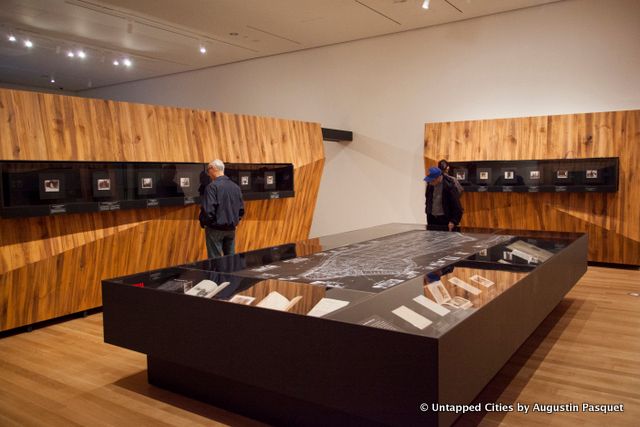
The first part of the main exhibition room focuses on images and materials from two of Riis’ books: How the Other Half Lives and The Children of the Poor. The latter shows Riis’ evolution from simply revealing slum conditions to showing the data and statistics behind child mortality, public health and education rates – information he gets from a friend who works as a statistician at the New York City Board of Health.

Five Cents a Spot, photo by Jacob A. Riis. Image via Museum of the City of New York, Gift of Roger William Riis
One of Riis’ most famous images is in this room, “Five Cents a Spot,” and the title of the photograph denotes that the subject is an illegal lodging house. The minimum rate for a bed in a lodging house then was 7 cents, but in the photograph many of the people depicted, of which there are around 15, are sleeping on the floor. Yochelson says, “This is a typical flash photo, where there is essentially no light in this room. [Riis] barges in, takes a picture with the flash, scares the living daylights out of the people – you can see it in their faces – the flash actually makes a burst of light and a boom – so it’s terrifying. Those were the first pictures.”

“Children’s Playground, Poverty Gap” by Jacob A. Riis. Image via Museum of the City of New York, Gift of Roger William Riis
The juxtaposition of photos from How the Other Half Lives and The Children of the Poor show the evolution of Riis’ technique. For The Children of the Poor, instead of bursting in unannounced, “he meets the child, and talks to the child, and is a reporter. And then in his writings, it’s a word and picture portrait,” describes Yochelson. And a year later, Riis combines his strategies – in one photograph in the exhibit, he enters a sweatshop on Ludlow Street and photographs it before he interviews the supervisor of the textile facility.
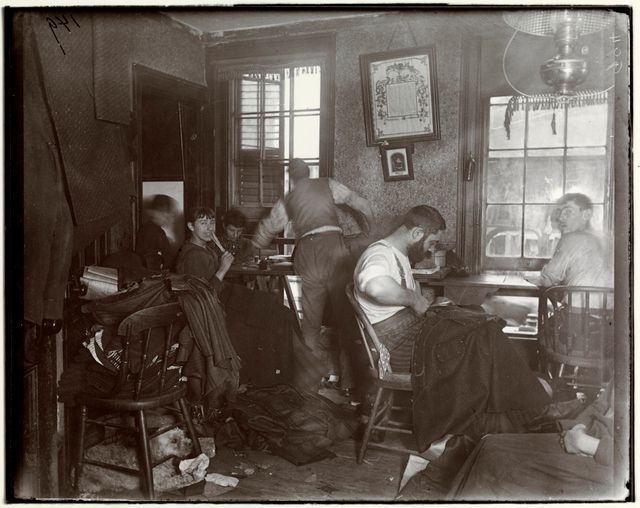
Riis journalistic style of photography also manifests itself today in the prints that remain, and have a direct impact on the type of exhibition the Museum of the City of New York has executed in Jacob Riis: Revealing New York’s Other Half. Unlike 20th century photographers who worked in a darkroom, Riis would take his negatives to commercial firms to develop and print the images.

The photographic collection discovered in the 1940s contained negatives, lantern slides, and prints. In the 1990s, Yochelson says, the Museum “made the determination that the best way to represent the collection was to make prints like the vintage prints that existed.” Chicago Albumen Works handled the project, using sunlight to develop the images, and the exhibition today features those prints made in the 1990s, all in a 4″ x 5″ size. The good news, Yochelson says, is that the prints are in a format Riis would recognize, “they’re not modern reinterpretations,” like the prior exhibit in 1948 and they show the mistakes that are in the negatives themselves. But she acknowledges the difficulty of a mounting an exhibit today without large scale prints, something Jacob Riis: Revealing New York’s Other Half overcomes with the collection of archival objects, materials,videos and a large-scale map showing the places in New York City Riis photographed.

The next section of the exhibition entitled “Making it as an American” looks at Riis’ celebrity status. One of the highlights is an excerpt of the manuscript from The Making of an American. A chapter is actually written by Riis’ wife, where she recounts their courtship and you can see Riis’ own edits where he removes a sentimental first paragraph. There is also Riis’ lantern slide box and a record of his breakneck lecturing schedule. A memorandum book shows that in just one month in February 1901 Riis visited 26 different cities, all before the advent of commercial flight.

A final portion of this area situates Riis vis-à-vis the Progressives – demonstrating that while he was a supporter of the movement (and vice-versa), he was of the era just before, and most importantly, self-taught. Yochelson notes, humorously, that both Mayor Fiorello LaGuardia and Robert Moses were fans of Riis, as evidenced today by the existence of Jacob Riis Houses and his namesake park in New York City.
This beautiful exhibit at the Museum of City of New York places Jacob A. Riis’ photographs in the context of his journalistic motives, providing the public a view into the person Riis was. Using the rich archive Riis carefully left behind, information from his numerous books, and the photographic collection from the musuem, curator Bonnie Yochelson has constructed a comprehensive view of one of New York City’s most important social reformers. Visit the exhibit Jacob Riis: Revealing New York’s Other Half to see many more photographs and materials.
Next, discover 10 must-see highlights of the Jacob Riis exhibit or read a walkthrough with the curator of another recent Museum of City of New York exhibit, “Affordable Housing: A New York Legacy.” Get in touch with the author @untappedmich.
Subscribe to our newsletter